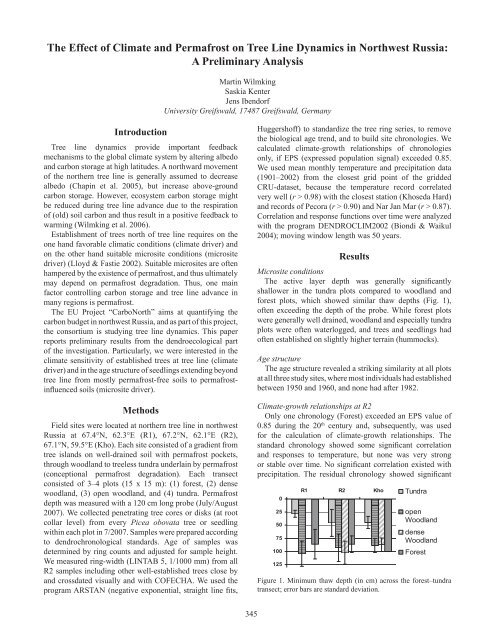Ninth International Conference on Permafrost ... - IARC Research
Ninth International Conference on Permafrost ... - IARC Research
Ninth International Conference on Permafrost ... - IARC Research
Create successful ePaper yourself
Turn your PDF publications into a flip-book with our unique Google optimized e-Paper software.
The Effect of Climate and <strong>Permafrost</strong> <strong>on</strong> Tree Line Dynamics in Northwest Russia:A Preliminary AnalysisMartin WilmkingSaskia KenterJens IbendorfUniversity Greifswald, 17487 Greifswald, GermanyIntroducti<strong>on</strong>Tree line dynamics provide important feedbackmechanisms to the global climate system by altering albedoand carb<strong>on</strong> storage at high latitudes. A northward movementof the northern tree line is generally assumed to decreasealbedo (Chapin et al. 2005), but increase above-groundcarb<strong>on</strong> storage. However, ecosystem carb<strong>on</strong> storage mightbe reduced during tree line advance due to the respirati<strong>on</strong>of (old) soil carb<strong>on</strong> and thus result in a positive feedback towarming (Wilmking et al. 2006).Establishment of trees north of tree line requires <strong>on</strong> the<strong>on</strong>e hand favorable climatic c<strong>on</strong>diti<strong>on</strong>s (climate driver) and<strong>on</strong> the other hand suitable microsite c<strong>on</strong>diti<strong>on</strong>s (micrositedriver) (Lloyd & Fastie 2002). Suitable microsites are oftenhampered by the existence of permafrost, and thus ultimatelymay depend <strong>on</strong> permafrost degradati<strong>on</strong>. Thus, <strong>on</strong>e mainfactor c<strong>on</strong>trolling carb<strong>on</strong> storage and tree line advance inmany regi<strong>on</strong>s is permafrost.The EU Project “CarboNorth” aims at quantifying thecarb<strong>on</strong> budget in northwest Russia, and as part of this project,the c<strong>on</strong>sortium is studying tree line dynamics. This paperreports preliminary results from the dendroecological partof the investigati<strong>on</strong>. Particularly, we were interested in theclimate sensitivity of established trees at tree line (climatedriver) and in the age structure of seedlings extending bey<strong>on</strong>dtree line from mostly permafrost-free soils to permafrostinfluencedsoils (microsite driver).MethodsField sites were located at northern tree line in northwestRussia at 67.4°N, 62.3°E (R1), 67.2°N, 62.1°E (R2),67.1°N, 59.5°E (Kho). Each site c<strong>on</strong>sisted of a gradient fromtree islands <strong>on</strong> well-drained soil with permafrost pockets,through woodland to treeless tundra underlain by permafrost(c<strong>on</strong>cepti<strong>on</strong>al permafrost degradati<strong>on</strong>). Each transectc<strong>on</strong>sisted of 3–4 plots (15 x 15 m): (1) forest, (2) densewoodland, (3) open woodland, and (4) tundra. <strong>Permafrost</strong>depth was measured with a 120 cm l<strong>on</strong>g probe (July/August2007). We collected penetrating tree cores or disks (at rootcollar level) from every Picea obovata tree or seedlingwithin each plot in 7/2007. Samples were prepared accordingto dendrochr<strong>on</strong>ological standards. Age of samples wasdetermined by ring counts and adjusted for sample height.We measured ring-width (LINTAB 5, 1/1000 mm) from allR2 samples including other well-established trees close byand crossdated visually and with COFECHA. We used theprogram ARSTAN (negative exp<strong>on</strong>ential, straight line fits,Huggershoff) to standardize the tree ring series, to removethe biological age trend, and to build site chr<strong>on</strong>ologies. Wecalculated climate-growth relati<strong>on</strong>ships of chr<strong>on</strong>ologies<strong>on</strong>ly, if EPS (expressed populati<strong>on</strong> signal) exceeded 0.85.We used mean m<strong>on</strong>thly temperature and precipitati<strong>on</strong> data(1901–2002) from the closest grid point of the griddedCRU-dataset, because the temperature record correlatedvery well (r > 0.98) with the closest stati<strong>on</strong> (Khoseda Hard)and records of Pecora (r > 0.90) and Nar Jan Mar (r > 0.87).Correlati<strong>on</strong> and resp<strong>on</strong>se functi<strong>on</strong>s over time were analyzedwith the program DENDROCLIM2002 (Bi<strong>on</strong>di & Waikul2004); moving window length was 50 years.ResultsMicrosite c<strong>on</strong>diti<strong>on</strong>sThe active layer depth was generally significantlyshallower in the tundra plots compared to woodland andforest plots, which showed similar thaw depths (Fig. 1),often exceeding the depth of the probe. While forest plotswere generally well drained, woodland and especially tundraplots were often waterlogged, and trees and seedlings hadoften established <strong>on</strong> slightly higher terrain (hummocks).Age structureThe age structure revealed a striking similarity at all plotsat all three study sites, where most individuals had establishedbetween 1950 and 1960, and n<strong>on</strong>e had after 1982.Climate-growth relati<strong>on</strong>ships at R2Only <strong>on</strong>e chr<strong>on</strong>ology (Forest) exceeded an EPS value of0.85 during the 20 th century and, subsequently, was usedfor the calculati<strong>on</strong> of climate-growth relati<strong>on</strong>ships. Thestandard chr<strong>on</strong>ology showed some significant correlati<strong>on</strong>and resp<strong>on</strong>ses to temperature, but n<strong>on</strong>e was very str<strong>on</strong>gor stable over time. No significant correlati<strong>on</strong> existed withprecipitati<strong>on</strong>. The residual chr<strong>on</strong>ology showed significant0255075100125R1 R2 Kho TundraopenWoodlanddenseWoodlandForestFigure 1. Minimum thaw depth (in cm) across the forest–tundratransect; error bars are standard deviati<strong>on</strong>.345
















